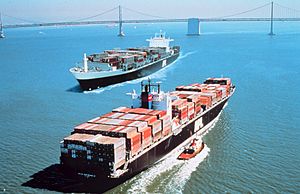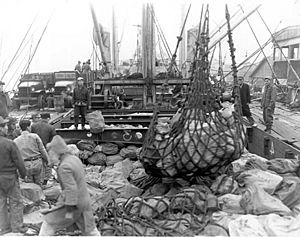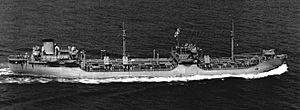Container ship facts for kids
Container ships are special cargo ships. They carry all their goods in large, truck-sized metal boxes called intermodal containers. This way of shipping is known as containerization. These ships are a very common way to move goods around the world. They now carry most non-bulk cargo across the oceans.
The size of a container ship is measured in twenty-foot equivalent units (TEU). A TEU is like a standard 20-foot long container. Ships usually carry a mix of 20-foot and 40-foot containers. The 40-foot containers are more common.
Today, about 90% of non-bulk cargo is moved by container ships. Modern ships can carry over 19,000 TEUs. Some of the biggest container ships, like the MSC Zoe, are as large as huge oil tankers and bulk carriers.
Contents
History of Container Ships
Before container ships, there were two main types of dry cargo. One was bulk cargo, like grain or coal. These were shipped loose in the ship's hull. The other was break bulk cargo, which meant goods packed in boxes, bags, or barrels.
Before the 1950s, loading break-bulk items was slow. Workers had to load each piece by hand. Then they had to tie it down. With containers, a huge amount of cargo (up to 64,000 pounds) can be moved at once. Each container is secured to the ship in a standard way.
Containerization made shipping much more efficient. It cut shipping time by 84% and costs by 35%. By 2001, over 90% of non-bulk goods were shipped in standard containers. In 2009, nearly a quarter of the world's dry cargo went by container. This was about 125 million TEUs of cargo.
The idea of using standard containers started a long time ago. In 1766, James Brindley designed "box boats" in England. These boats used 10 wooden containers to move coal. Before World War II, special container ships carried luggage for luxury trains. These trains went from London to Paris.
The first modern container ships were old T2 tankers from World War II. They were changed to carry containers. In 1951, the first ships built just for containers started working. They sailed in Denmark and between Seattle and Alaska.
The first truly successful container ship was the SS Ideal X. It was an old tanker owned by Malcom McLean. In 1956, it carried 58 metal containers from Newark, New Jersey to Houston, Texas. This trip started a big change in how goods were shipped.
Container ships are different from older cargo vessels. They have huge open spaces inside called "cells." These cells have vertical guide rails. These rails hold the containers in place. Shipping containers are usually made of steel. They can also be made from aluminum or other materials.
Containers are designed to be easily moved. They can go from ships to smaller boats, trains, and trucks. This is why it's called intermodal transport. There are many types of containers. They come in different sizes and for different uses.
Containerization changed shipping and world trade. A container ship can be loaded and unloaded in hours. Older ships took days. This saves money on labor. It also makes shipping times much faster. For example, a trip from India to Europe now takes weeks instead of months.
There is also less damage to goods. This is because containers are handled less. Goods are also safer from theft. Containers are sealed and only opened at their final destination.
Containerization has made shipping cheaper and faster. This has helped international trade grow a lot. Goods that used to arrive in many small packages now come in sealed containers. Machines can scan product codes on the containers. Computers can track them very precisely.
This tracking system is so good that a two-week trip can be timed to arrive within 15 minutes. This has led to things like "on-time guaranteed delivery." It also helps with "just-in-time manufacturing." Raw materials can arrive from factories just before they are needed. This saves companies money on storage.
Today's largest container ships are about 400 meters (1,300 feet) long. They can carry as much cargo as 16 or 17 older ships from before World War II.
How Container Ships Are Built
Modern container ships have a special design. Their hull is built around a strong keel. The hull is the main body of the ship. Inside the hull are cargo holds. These are large spaces for containers. There are also many tanks and an engine room.
The cargo holds are covered by hatch covers. More containers can be stacked on top of these covers. Many container ships have their own cranes to load and unload. Some have special systems to hold containers firmly in place.
The hull of a modern cargo ship is made of steel plates and strong beams. The keel is like the ship's backbone. Frames, like ribs, are attached to the keel. The main deck covers the top of the hull. Beams support the deck and make the ship strong.
Many new ships have "double-bottom tanks." These are like a second watertight layer at the bottom. They usually hold fuel, water, or ballast water.
The ship's engine room holds the main engines. It also has other important machines. These include systems for fresh water, sewage, and electricity. Fire pumps and air conditioners are also there. On most new ships, the engine room is at the back.
Container Ship Sizes
Container ships come in 7 main size groups:
- Small feeder
- Feeder
- Feedermax
- Panamax (can fit through the original Panama Canal)
- Post-Panamax (too big for the original Panama Canal)
- New Panamax (can fit through the newer, wider Panama Canal locks)
- Ultra-large
As of 2012, there were 161 "Very Large Container Ships" (VLCS). These ships can carry more than 10,000 TEUs. Only 51 ports in the world can handle ships this big.
Cargo Holds and How They Work
Container ships are designed to be very efficient. Their cargo holds are built to load and unload containers quickly. They also keep containers safe at sea. A key part of this design is the hatches. These are the large openings from the main deck to the cargo holds.
The hatch openings go across the entire width of the cargo holds. They are surrounded by a raised steel structure called a hatch coaming. On top of the coamings are the hatch covers.
In the past, hatches were covered with wooden boards and tarps. Today, some hatch covers are solid metal plates. Cranes lift these plates on and off the ship. Other covers are special folding mechanisms. They open and close using powerful hydraulic systems.
Another important part of container ship design is cell guides. These are strong metal structures inside the cargo holds. They guide containers into neat rows during loading. They also help support containers when the ship rolls at sea. Cell guides are so important that they help tell a container ship apart from other cargo ships.
To plan where containers go, a three-part system is used:
- The BAY is the position from the front of the ship to the back. Bay numbers start at the front and increase towards the back.
- The TIER is the height. The first tier is at the bottom of the hold.
- The ROW is the position across the ship. Rows on the right side (starboard) have odd numbers. Rows on the left side (port) have even numbers. Rows closer to the center have lower numbers.
Container ships mostly carry 20-foot, 40-foot, and 45-foot containers. The 45-foot containers only fit above deck. 40-foot containers are the most common. They make up about 90% of all container shipping. Since container shipping moves 90% of the world's freight, over 80% of all global freight moves in 40-foot containers.
Images for kids
See also
 In Spanish: Buque portacontenedores para niños
In Spanish: Buque portacontenedores para niños














